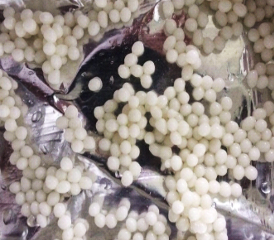 |
|
Novel hydrogel beads were formed by ionic gelation between sodium alginate-nopal mucilage (SA-NM) for enhancing the encapsulation efficiency and oxidative stability of sesame oil (SO). SA-NM blends (2% w/v) were used 1:1 and 1:1.5 mass ratios. Ionic gelation was induced by dripping the SO-SA-NM homogenized dispersions with the help of a syringe into CaCl2 (2.5% w/v) solution with continuous stirring. The resulting beads were oven-dried and stored under controlled temperature conditions. The hydrogel beads were evaluated for size and shape, and for SO encapsulation efficiency, oxidative stability, and release kinetics. Results were compared with hydrogel beads made with only SA (2% w/v). The SA beads had a regular spherical shape with a mean size of ~2.19 mm, while the SA-NM hydrogels beads had an irregular semi-spherical shape with a significant smaller (~2.06-2.10 mm) size. SA-NM hydrogel beads displayed higher encapsulation efficiency (> 75.44%) than SA beads (63.48%), and provided better protection to SO against oxidation during storage than the SA beads and free SO oil. Oxidation kinetics were of zero-order in all cases. The release kinetics of SO was diffusion controlled and was significantly slower for SA-NM than for SA beads. Our results indicate that SA-NM mixtures may be considered as novel potential additives for food industry applications.
Keywords: Nopal mucilage, Sodium alginate, Ionic gelation, Sesame oil, Oxidative stability, Encapsulation efficiency.
|
|
 |

